Productivity and sustainability go hand in hand for the rural sector
If any sector knows how to improve productivity, it’s our primary sector which was responsible for a massive $56 billion worth of exports in 2023. Over the last 40 years, our farmers have achieved sustained, year-on-year growth in crop and livestock production per hectare. In sheep farming alone, Landcare Research data shows that farmers have achieved a 25% increase in lambing percentage and carcass weight since the 1980s. Sheep productivity per labour unit has also improved by 35%.
Those gains are impressive, but our primary sector producers will need to double down on that commitment to productivity improvements as they face dramatic changes in the markets that receive our primary products, says Aidan Gent, ASB’s General Manager, Rural.
“The Nestles and Krafts of the world, as well as retailers like Tesco and Sainsbury’s now have sustainability requirements for their entire supply chain that go beyond what the New Zealand Government signed us up to with the Paris Climate Accords,” he says.
“Our rural customers have generally found that the most productive farm practices also yield the greatest gains when it comes to sustainability. These two things increasingly go hand in hand when farmers make investment decisions,” Gent adds.
Research and development to advance genetics and breeding techniques, and innovation in on-farm technology to improve water and fertiliser use, and farming system changes, have driven efficiency gains in farming and horticulture.
Weathering the storm
But with the primary sector weathering the impact of high interest rates, inflation, and soft commodity prices in key markets, investing in productivity-boosting projects hasn’t necessarily been top of mind in recent years, Gent points out.
“It’s been a challenging period for farmers from an earnings perspective, especially for those in the red meat sector and those impacted by the severe weather events particularly when you overlay it with the fastest rise in official cash rate history,” Gent points out.
But generations of Kiwi farmers have shown resilience through economic cycles as well as drought and biosecurity incidents like the Mycoplasma bovis outbreak. Now is the ideal time for them to invest for the future, meeting the needs of sustainability-minded consumers all over the world.
That’s why ASB is making up to $500 million in loans available specifically for productivity-enhancing initiatives across New Zealand’s primary sector and other industries. The loans are accompanied by $5 million in ASB Productivity Grants, up to $50,000 per business (1% of the loan), available for a limited time to borrowers to help kickstart their productivity improvements.
“The capacity to innovate is there in many parts of the rural sector, but farmers are lacking a bit of confidence in the current climate, with many choosing to be very conservative in their spending which is important for near-term resilience, but needs to be balanced with longer term success,” says Gent.
ASB’s Rural Managers are working with farmers and horticulturalists to help them understand the long-term impacts of investing in productivity and tailoring solutions to meet their business requirements.
“Our dairy, beef and sheep farmers have the united goal of growing export markets rather than competing aggressively with each other, so there’s a willingness to share information and lift the performance of the sector as a whole,” says Gent.
Small investments add up
ASB loans have funded everything from automatic cupping systems in milking sheds to dung beetles. Temperature sensors that trigger automated frost prevention irrigation systems and fans saved numerous kiwifruit growers from losing their crops last year.
“One farm we work with was able to reduce its water usage by 50 per cent, just by upgrading old irrigation infrastructure,” says Gent.
“But more common are the incremental improvements that don’t require massive investment, and lead to one or two per cent improvements here and there,” adds Gent, himself a “weekend dairy farmer” who has installed smart sensors on his farm for real-time status updates.
“I can go into an app on my phone and see at any time how much water is being used on the farm, how much milk is in the vat and whether the chillers are turned on,” he says.
Debate continues about how to price agricultural greenhouse gas emissions in New Zealand and requirements on farmers to reduce their on-farm emissions will require technology that is still to be fully developed.
But ASB customers aren’t waiting around for rules to be set, says Gent, who has talked to numerous farmers and horticulturalists since the Productivity Grants were launched.
“If you talk to most farmers in New Zealand today, they are farming differently to how they did ten years ago,” Gent says.
“The majority of their investment decisions are aimed at solving a series of problems, or pursuing opportunities across productivity and environmental sustainability. The two areas go hand in hand within the food & fibre sector and present a real opportunity.
“ASB has a role to play in kick-starting the conversation about how we can do more to support both and we can make loans available to make it a reality.”
To find out more about ASB’s Productivity Grants, visit asb.co.nz/productivity
ASB Bank Limited’s lending and eligibility criteria, terms and conditions, rates and fees apply. Offer is subject to change and may be withdrawn at any time.
– Hero image - Aidan Gent, ASB’s General Manager of Rural Banking






